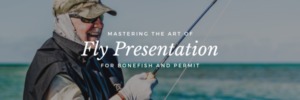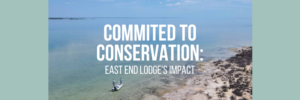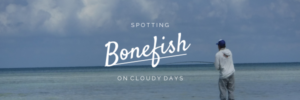One of the best ways to ensure that your bonefishing trip is a productive one is by bringing your own gear.
If you’ve never gone fishing for bones before, you might be tempted to go on a full-out shopping spree. However, it’s important to avoid crossing the line between being well-equipped and being over-equipped. Too much gear will weigh you down and make it infinitely more difficult to find what you need in a pinch. Some items will work better in other seasons and locations than others, and some won’t be necessary at all. Check out this list of seven essentials for bonefishing to find everything you absolutely need to bring along.
1. Rod and Reel
Lodges don’t generally have large selections of rods and reels for novice fishers who forget to bring their own. When they do have these items available, they aren’t guaranteed to have the right fit and feel for your needs, and they’re rarely well-maintained. Rods and reels are two basic items that every bonefisher is expected to bring along. After all, you wouldn’t show up for a marathon without a comfortable pair of running shoes.
When selecting a rod for fly-fishing, it’s all about the trip you’ll be taking and your personal preferences. You’ll find options made from fiberglass, bamboo, and graphite. However, graphite tends to be the most popular choice. It’s lightweight, durable, and easy to handle, even as it remains sturdy enough to handle heavy, aggressive fish. With options ranging between seven and nine feet, be sure to pick one that feels good in you’re hands and that you can easily manage. For ease of transport, consider looking for a rod that comes in a nice travel case.
When it comes to reels, consider craftsmanship and the environment you’ll be in. There are countless reels to choose from, and reels for nearly ever type of fishing. Consider how much line your reel will hold, and how smooth the drag is. A smooth drag will allow for ultra-quick strikes and longer runs when larger fish go on the move. A good reel, or one that’s been expertly machined, can last a long time if its well-cared for. Options that are cold-forged tend to be strongest, and they boast the greatest amount of corrosion-resistance.
2. A Flies and Hooks Box
A decent flies and hooks box is the next item on your list of essentials. Every location has what’s known as “hot flies” or flies that perform best in the environment. These are options that local fish tend to be most responsive to, and more often than not, this is due to their ability to accurately mimic local fish food. When planning a bonefishing trip, be sure to find out what the “hot flies” are. This way, you can stock your flies and hooks box accordingly. To increase your chances of attracting and catching bonefish, consider carrying a lightweight fly box that can hold multiple fly types. Some options can carry up to 100 pieces, including fly fishing lures that have been handmade, nymphs, streamers, dry and wet flies, and emergers. You’ll want this box to be waterproof, easy to carry, and easy to open and close. The best designs are small enough to store right in your fishing vest.
3. Fly Fishing Line, Leaders, and Tippets
Leaders protect your line against wind damage and breakage. Often invisible to fish, tippets are tiny gauges that help the fly line swim or float naturally. Your leaders should have an evenly tapered thickness for accurate, long casts and optimum energy transfer. Both leaders and tippets perform best when they can be easily connected to the line. For your first few times out, consider a weighted forward line with an adequate diameter and an additive for assured slickness. You can find tapered leaders in various sizes to accommodate most line styles and types. Check for options that are easily straightened and connected with loops.
4. Fly Fishing Net
Bonefishing is largely a catch-and-release sport. Few people retain these fish and even fewer still eat them. In fact, nearly everywhere you go, catch-and-release is the only type of bonefishing legally allowed. Thus, it makes good sense to bring along a good net. A net will minimize stress while you remove your hook. It will also make it easier to check out and photo your catch before sending him on his way. Look for a large, rubberized landing net that’s virtually impossible to see once underwater. This will keep bonefish from getting spooked and prevent them from fighting.
5. Floats and Strike Indicators
Essential for identifying a feeding fish that’s out of view, floats and strike indicators are often referred to as bobbers. They should be easy to use and easy to see. They best options won’t slip off the line, cause the leader to kink, or move randomly.
6. Multi-tools
Great multi-tools are essential to pack along. These innovative combinations will limit the amount of gear that you have to haul, even as they ensure that you’re never without the equipment you need. Look for a multi-tool that includes pliers. If your multi-tool has a suitably large knife, all the better. Otherwise, pack a small, folding knife in your vest. A good pair of pliers will come in handy when you need to cut the shank off a hook, cut a hook, or trim your line.
7. Waders and Boots
Not all bonefishing is done from a boat. When you get ready to wade the flats, you’ll want to have footwear that’s right for the rocky and often unpredictable bottom. Look for lightweight waders that are easy to put on and easy to move around in. If you opt for boots instead, make sure that they’re large enough to accommodate thick socks. Before hitting the flats, take the time to break your boots or waders in. This way, they’ll fit, feel, and function good when you need them to.
With these seven essentials, you should have everything you need for a comfortable, productive trip. You can also toss a pair of polarized sunglasses into your bag for fighting the glare, a bottle opener, and a few high-protein snacks to keep yourself energized. When properly prepared for these outings, you’ll be ready to respond to whatever action comes your way.








